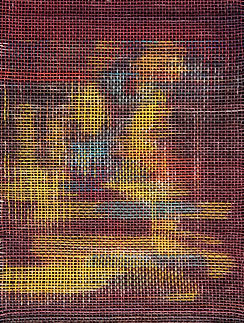
ARCHIVIO ALMAVIVA ha aggiornato la propria privacy policy secondo la normativa europea in materia di protezione dei dati (GDPR).
Perché, dopo oltre 70 anni dalla nascita dello Spazialismo, è importante pensare alla realizzazione di un "olio su tela” senza disporre della tela su cui dipingere?

ARCHIVIO ALMAVIVA
Com’è possibile una pittura in cui gli specifici elementi pittorici facciano esplicito riconoscimento del carattere letterale del supporto? Nell’ambito della Post-painterly abstraction, la stain technique sembrava la soluzione migliore: per la sua realizzazione sembrava bastare la semplice resistenza della tela – niente di più, niente di meno. Il colore diluito avrebbe dovuto identificarsi con la stessa tela, per quanto non giungesse mai a garantire la piena corrispondenza tra il recto e il verso del dipinto.
Ma con lo Spazialismo di Fontana, è venuto meno lo stesso principio del supporto piano su cui operare. La questione si è posta pertanto in termini radicalmente nuovi, tanto da richiedere una soluzione apparentemente paradossale. Si è infatti realizzato un dipinto sulla base di procedure inverse rispetto alla stain painting. Il colore anziché diluito, rimane nella sua corposità e la tela come premessa pittorica è stata eliminata. Un Artefatto (Rectoverso), un’opera totalmente literal, al punto che il recto e il verso del nuovo dipinto sono pienamente corrispondenti.
HORROR VACUI
Le conseguenze dello Spazialismo: lacerata la tela, si è aperto il vuoto. Non ci sarebbe stata un’altra superficie su cui riorganizzare il lavoro una volta infranta la bidimensionalità del supporto. O, al limite, un quadro ma senza la tela su cui dipingere – ammesso che fosse stato possibile. Per sopravvivere la pittura ha invece pensato di trasformarsi, esorcizzando il vuoto. Ha inglobato oggetti del mondo reale, proprio ripristinando la materialità del supporto come presupposto irrinunciabile per fare arte. Ma diversa è la risposta di una pittura che rinuncia alla precondizione della superficie e che, inevitabilmente, inserisce il vuoto nelle sue procedure.


Il discorso modernista ha affermato il principio per cui la tela partecipa, in termini visuali, con gli altri elementi organizzati sulla sua superficie. La pittura si è caratterizzata sempre più come procedura, fisicamente costituita, capace di attivare materiali diversi in relazione alla planarità del supporto o a diverse superfici. “Always the surface is used,” affermò un celebre pittore americano.
Ma cosa accadrebbe se, nel suo farsi, venisse a mancare il suo necessario supporto piano? Come dovrebbero essere ripensati i concetti e le pratiche basilari della pittura, dal semplice tracciare una linea alle più complesse operazioni composizionali?
In tal caso, potremmo concepire una linea che sia al tempo stesso “a pure trace of a process” e un segno che si forma “in the materiality of painterly production”?
L’Artefatto (Rectoverso) è un primo e concreto esempio di una pittura senza superficie
“Pollock’s line bounds and delimits nothing …” Così Michael Fried sintetizzava una delle maggiori conquiste dell’arte americana, giunta a compimento di un lungo percorso iniziato con le avanguardie di primo Novecento. Liberare la linea dal suo (reiterato) “task of describing and bounding shapes and figures – whether abstract or representatives – on the surfaces of the canvas.”
Abolita qualsiasi sua funzione denotativa, alle neo-avanguardie si sono aperte nuove possibilità di riconcettualizzare la linea, innanzitutto come continuum spazio-temporale che obbedisce alla propria logica – al di là di ogni dipendenza dalla gestualità dell’artista.
Ma questa esigenza di autonomia può realizzarsi davvero se sul piano procedurale la linea rimane dipendente dal suo alveo naturale, ovvero dalla superficie sulla quale anche idealmente può essere tracciata?
Proviamo a invertire i termini della questione: una pittura che rinuncia alla superficie.
L’Artefatto (Rectoverso) è una prima soluzione a questo tipo di problemi.



ARCHIVIO ALMAVIVA
Via Cessana, 28, 51011 Buggiano PT, Italia
+39 0572 33511
Contatti




